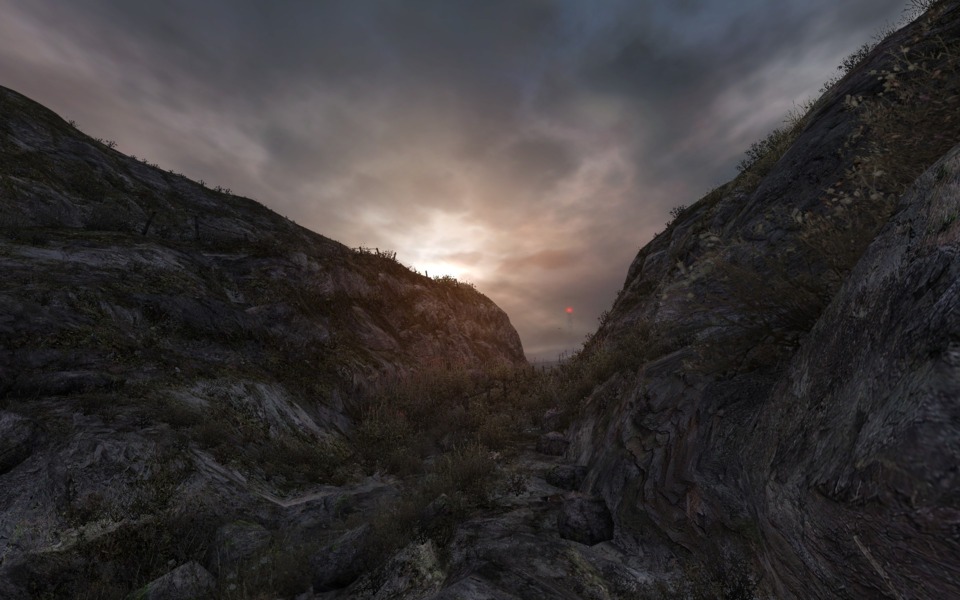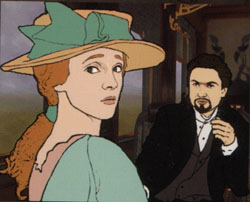Walkabouts and Space-Time
By MarkWahlberg 0 Comments
As someone who is perpetually working through their gaming backlog, the steam Christmas sales are pretty handy. Among other things, I finally got around to playing Dear Esther, one of the earlier titles in the recent profusion of what I’ve taken to calling the Walkabout genre – Stanley, Gone Home, maybe Proteus, etc. Although those games are mechanically similar, in that you move around in an environment while disembodied voices speak to you, I think it’s interesting that the most direct comparisons each game brings up are outside gaming entirely. The Stanley Parable is a Monty Python sketch, Gone Home is a YA novel/afterschool special, and Dear Esther is one of those short stories or poems you read in AP English.

In Dear Esther’s case, I think this comparison is important, because it underlines both the strength and weakness of the game Playing it requires, not a suspension of disbelief, exactly, but a suspension of expectation, at least for someone who plays games regularly. The island itself is stunningly realized, and I think it’s important to note just how quickly the game would fall apart if the environmental design had not been so well implemented – a case of talent making hard work look easy. You could remove the narration entirely, and Dear Esther would still be commendable simply as a thing to look at. But the extremely deliberate pacing, and the metaphorical/abstracted nature of what it’s doing, mean that worrying about ‘doing it right’ or missing something can get in the way of playing it. As much as the game takes advantage of the sense of place, of physical presence, that the medium allows, it’s also hampered by that same aspect. With a poem or a story, oblique or abstract methods in relaying information are easier to swallow because you can always go back and re-read sections, poring over the material and digging up meaning. Here, there is only one way to go: forward, and at a deliberate pace set by the game. Walking off the beaten path is allowed, but usually just means you’re going to spend more time trying to get back on it than anything else. Replaying is a possibility, but because the whole thing acts as one, holistic experience, going back and fiddling around takes away from that experience dramatically. And unlike in Gone Home, there’s no way of re-listening to earlier bits in the tale the Narrator is telling, so you’re left with more of a general impression of what’s going than anything else. The game is what it is, beautiful and weird, and then you turn into a seagull and it’s done.

The same criticisms could be applied to a much older game, albeit for different reasons. An adventure game from the long forgotten age of 1997, The Last Express is set on the Orient Express literally days before the beginning of World War One. Perhaps the most notable aspect of the game is the progression of time: events on the train proceed according to a set schedule, which means that A) things are happening even when you’re not there, and B) you’ll probably end up using the rewind feature because you were dicking around in the dining cabin instead of doing whatever you need to be doing. While an interesting concept, it is not without its problems. Between not always knowing what to do next, and waiting for something to actually happen, you spend a fair amount of the game running back and forth along the train like a maniac. Compounding that, the age of the game means you’re clicking on the screen to move, original Myst style, rather than actually moving a character, and constant clicking gets very old very quickly. Once you actually know what to do, the puzzles are usually pretty straightforward, and while the story starts out interestingly enough, it sort of fizzles out at the end in a David Cage-ean fantasy mess.
Juxtaposing Express with Esther like this wasn’t a deliberate idea when I bought them, but having the two side by side made it surprisingly clear how they’d taken different approaches to achieving the same thing. The characters in Express have set behaviors and patterns to their lives on the train, and despite the interface being extremely dated, having that constant flow does add quite a bit to the game’s atmosphere. The passage of time would be essentially meaningless without those characters, which is perhaps why the concept hasn’t been explored as much since, aside from day/night cycles in RPGs. While Express would benefit greatly from an HD Superfancygraphix Remix Edition, I’d be more interested in someone applying the activity, the flow of a game like that to something like Esther or Gone Home, which create a very specific, carefully thought out area with which the player interacts. NPC’s fleshing out a space in a game is not a new concept, but for something that focuses on a very specific place in a very specific moment in time, throwing in a cast of characters doing their own thing could allow for some very interesting possibilities. To be clear, I’m not saying they should have had people; the barren emptiness of Esther, and the mysterious loneliness of Gone Home, are crucial to what those games are doing.
The recently announced No Man's Sky blew everyone's socks off, claiming to offer a whole galaxy to explore, but what I'm arguing for is a push in the other direction. A few years ago someone (edit: Googling shows it was Warren Spector) was kicking around the idea of a ‘One City Block’ game, something that was just a real deep cut on a very small area, fully fleshed out. The appeal of this concept is obvious, as are the difficulties with AI and all that. But I think, especially now that we’re entering a new generation of games, this could be an area where mid-tier games could potentially stage a tiny comeback, fitting in between the all-consuming madness of MOBAs and the constant push for bigger worlds in RPGs.
Also, I just want more games that are set on trains.
